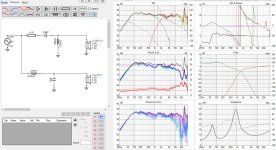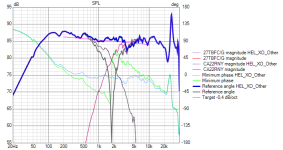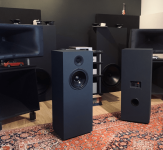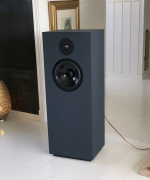For those of us guys, in our best age, who likes old school speakers with large high sensitivity paper midwoofer and wide baffle here it is.
We are goong back to the good old Snell days but with more dynamics and especially details in the treble. The alu dome tweeter sounds indeed good. And you can play loud to.
One of the major benefits with 8 inch and wide baffle is warmer lower midrange and very good punch in the bass. It sounds good with all kind of music.
It is also an easy load for the amp.
Some will comment the power response dip in the crossover area in this and all 8 inch + dome tweeter constructions but to be honest, the sum of advantages will make up for this. And you can barely hear it.
The drivers is as «high end» as you are used to in the HiFi shop, but not expensive though.
Complete drawing and crossover description is here:
https://www.seas.no/index.php?optio...s-aphel-kit&catid=66:seas-diy-kits&Itemid=345

We are goong back to the good old Snell days but with more dynamics and especially details in the treble. The alu dome tweeter sounds indeed good. And you can play loud to.
One of the major benefits with 8 inch and wide baffle is warmer lower midrange and very good punch in the bass. It sounds good with all kind of music.
It is also an easy load for the amp.
Some will comment the power response dip in the crossover area in this and all 8 inch + dome tweeter constructions but to be honest, the sum of advantages will make up for this. And you can barely hear it.
The drivers is as «high end» as you are used to in the HiFi shop, but not expensive though.
Complete drawing and crossover description is here:
https://www.seas.no/index.php?optio...s-aphel-kit&catid=66:seas-diy-kits&Itemid=345
Last edited:
Yes, I thought it was very nice too. There is a lack of 8" plus 1" designs for the diy people and SEAS seem to have done a better crossover (with a 2.2kHz cross) than their usual slightly simplistic designs.
I recall @Pano did something like this some years back. He liked it. Maybe with a SEAS CA22RNX. Can't remember.
https://www.seas.no/index.php?optio...2rnx&catid=44:utv-prestige-woofers&Itemid=238
Must sim it!

Have you built it?
I recall @Pano did something like this some years back. He liked it. Maybe with a SEAS CA22RNX. Can't remember.
https://www.seas.no/index.php?optio...2rnx&catid=44:utv-prestige-woofers&Itemid=238
Must sim it!
Have you built it?
Hi. No, havent build it. Havent seen it before? 🙂
The CA22RNY was chosen to get as high sensitivity as possible with the range of Seas woofers from the Prestige serie.
The alu dome with ferrofluid is capable of 2200 Hz crossover with very low distortion. And it is very smooth. The breakup is far away from what i can hear. The little plastic lens under the metal mesh makes fine polar response upwards. I think it is sound quite like DXT with a lot of details and good headroom.
The CA22RNY was chosen to get as high sensitivity as possible with the range of Seas woofers from the Prestige serie.
The alu dome with ferrofluid is capable of 2200 Hz crossover with very low distortion. And it is very smooth. The breakup is far away from what i can hear. The little plastic lens under the metal mesh makes fine polar response upwards. I think it is sound quite like DXT with a lot of details and good headroom.
My Zingers were very similar 8" 2way as well, uses same tweeter.
Is it really the same tweeter, it certainly looks and specs the same; if so, the Peerless is about a third of the price in Oz! Now, if only there were a woofer which was the same as the SEAS - that's around $300 apiece shipped to Australia.
The Daytons in the Zingers are about $A110: solution: build the Zingers!
Geoff
The Daytons in the Zingers are about $A110: solution: build the Zingers!
Geoff
I used the DA25BG0806 first, but it went NLA. I swapped in the 27TBFCG and didn't change a thing in the xover. Not that it would always be the case between the 2, as they are and do sound a bit different. The Seas appear to be slightly lower distortion than the Peerless and the top octave varies a bit between the two.
Why the crossover of this design Aphel is so complicated when you can do the same or better with much less components ? I am a fool who miss something ?
Thanks to SEAS to share the data. I would like to have an achenoic chamber too to make same measurements.
Thanks to SEAS to share the data. I would like to have an achenoic chamber too to make same measurements.
Attachments
You can make a lot of different filter who sound good.
This original Seas filter sounds very good and for DIY’ers who dont simulate and make own crossovers a complete kit instruction like this makes it very easy to make a high quality speaker whitout special knowledge.
To evaluate a speakers quality just theoretical gives a limited impression. Thats one of the major drawbacks with hi-fi forums. Its always a huge risc to jump to conclusions.
The beauty with kit descriptions from Seas who is for free (for personal use) is that it is 100% open and the DIY’ers are free to do whatever they want. The most inportant thing is to be happy.
One smart option is to make different outboard filters and test ABX.
Here is another alternative filter to the same speaker who measure wrong with dips (like Pro-Ac 🤭) but sounds good with tube amps. (This is not a filter from Seas):
https://www.hifisentralen.no/forumet/threads/diy-toveis-seas-gulvstående-hortenmessa-2023.107711/page-2#post-3969928
This original Seas filter sounds very good and for DIY’ers who dont simulate and make own crossovers a complete kit instruction like this makes it very easy to make a high quality speaker whitout special knowledge.
To evaluate a speakers quality just theoretical gives a limited impression. Thats one of the major drawbacks with hi-fi forums. Its always a huge risc to jump to conclusions.
The beauty with kit descriptions from Seas who is for free (for personal use) is that it is 100% open and the DIY’ers are free to do whatever they want. The most inportant thing is to be happy.
One smart option is to make different outboard filters and test ABX.
Here is another alternative filter to the same speaker who measure wrong with dips (like Pro-Ac 🤭) but sounds good with tube amps. (This is not a filter from Seas):
https://www.hifisentralen.no/forumet/threads/diy-toveis-seas-gulvstående-hortenmessa-2023.107711/page-2#post-3969928
Last edited:
@jerome69
If you look at your response compared with the Seas filter, the latter has a little more even respons around the crossover region and a little lift around 10K. I think it is much effort here to fine tune the respons. And i have heard the filter and it sounds very good 👍
That said, you just have to test which you like best as i mentioned previous. Nice work you did with simulations btw 😊


If you look at your response compared with the Seas filter, the latter has a little more even respons around the crossover region and a little lift around 10K. I think it is much effort here to fine tune the respons. And i have heard the filter and it sounds very good 👍
That said, you just have to test which you like best as i mentioned previous. Nice work you did with simulations btw 😊
Thank you !If you look at your response compared with the Seas filter, the latter has a little more even respons around the crossover region and a little lift around 10K. I think it is much effort here to fine tune the respons. And i have heard the filter and it sounds very good 👍
That said, you just have to test which you like best as i mentioned previous. Nice work you did with simulations btw 😊
Yes I am agree the response of the SEAS crossover is more uniform above 1KHz but mine has +1dB more sensitivity (less resistance on the woofer but could change the box tuning) and a better phase tracking. The least but not last less component, for a lower the price of the crossover. And yes mine needs some fine tuning and extensive listening.
Sure the SEAS crossover sounds good, not is the object of my astonishment 😉 but for me, used to design 8"+1", this crossover is curious. And honestly if I put more components I'd go to a four order electrical crossover on the tweeter, a better time alignment with the woofer but it is an other story 🙂
Attachments
SEAS has a problem with DIYS. Put it simple, a 400$ kit should not sound better than a 4000$ commercial speaker.
Seas is primarily an OEM supplier for high end manufacturers all over the world. DIYS is just a tiny fraction of the sales volume.
If your brand is too present in DIYS, some may think it devalues the brand. Look at Focal, Dynaudio, Tymphany and all the brands around HECO. They ended selling to the hobby market while sales were high.
DIYS is good to make your brand present and established it in the market, but later seen as devaluing by the super smart management guys.
We can be happy Seas still sells openly, but don't expect high end kits from their side. There are others out there that do far better.
Concerning the crossover, there is hardly anyone who can really comment without knowing the cabinet the drivers are in and measuring the whole construction. Also, there are people loving to use many parts in a crossover, to make the response ruler flat. Often these people are somehow connected to manufacturers of overpriced coils, caps and resistors. These ruler flat responses are, of course, only measured in one certain room. If you build it for your home, there will be nothing left of this perfection.
Which doesn't mean that well behaved speakers are bad, but simple passive crossovers often sound more vivid than graves full of components. Which is, of course, a personal opinion and a question of the room and the components used for the speaker.
Seas is primarily an OEM supplier for high end manufacturers all over the world. DIYS is just a tiny fraction of the sales volume.
If your brand is too present in DIYS, some may think it devalues the brand. Look at Focal, Dynaudio, Tymphany and all the brands around HECO. They ended selling to the hobby market while sales were high.
DIYS is good to make your brand present and established it in the market, but later seen as devaluing by the super smart management guys.
We can be happy Seas still sells openly, but don't expect high end kits from their side. There are others out there that do far better.
Concerning the crossover, there is hardly anyone who can really comment without knowing the cabinet the drivers are in and measuring the whole construction. Also, there are people loving to use many parts in a crossover, to make the response ruler flat. Often these people are somehow connected to manufacturers of overpriced coils, caps and resistors. These ruler flat responses are, of course, only measured in one certain room. If you build it for your home, there will be nothing left of this perfection.
Which doesn't mean that well behaved speakers are bad, but simple passive crossovers often sound more vivid than graves full of components. Which is, of course, a personal opinion and a question of the room and the components used for the speaker.
For the record, DIY is not a «tiny fraction» of the turnover at Seas if you mean a tiny fraction is like 1% 😊
Regarding the amount of parts in the crossover. When the emperor criticizes Mozarts music 🤭
Last edited:
Uhi, did I step on a mine? OK, maybe crossover parts are not overpriced, just ridiculous expensive?
What is your profession?
How comes that you can get industry parts with the same performance (just without bees wax, fairy dust, silver and gold) for a fraction of the the price such "special audio parts" cost.
Can you explain what difference the electron experiences, when it passes through a 15$ 1uF capacitor, compared to an identical build part, just labeled WIMA, Siemens or what ever, for a few cent?
Sorry, 90% of all the Mundorf, Jantzen and other products are heavily soaked in snake oil. Buy some copper wire and wrap your own coil, then tell me how complicated it was and what the price of an once of it was. Nothing complicated...
Anyway, the aera of the passive crossover has ended, even as some don't realize it. With prices for an DSP about that of capacitor made for audio and a few channels of D-amps that of a bass coil, the new generation of DIYS audio folks will not need it any more.
Enjoy the last years!
What is your profession?
How comes that you can get industry parts with the same performance (just without bees wax, fairy dust, silver and gold) for a fraction of the the price such "special audio parts" cost.
Can you explain what difference the electron experiences, when it passes through a 15$ 1uF capacitor, compared to an identical build part, just labeled WIMA, Siemens or what ever, for a few cent?
Sorry, 90% of all the Mundorf, Jantzen and other products are heavily soaked in snake oil. Buy some copper wire and wrap your own coil, then tell me how complicated it was and what the price of an once of it was. Nothing complicated...
Anyway, the aera of the passive crossover has ended, even as some don't realize it. With prices for an DSP about that of capacitor made for audio and a few channels of D-amps that of a bass coil, the new generation of DIYS audio folks will not need it any more.
Enjoy the last years!
https://www.diyaudio.com/community/...ay-with-8-inch-midbass-mini-waveguide.381537/
What color is used for the New Seas Aphel speaker kit and this one?
What color is used for the New Seas Aphel speaker kit and this one?
Attachments
Last edited:
Turbowatch2 you make some good points, I disagree about the death of passive crossovers. The DIY community will almost surely have people messing around with discrete components just because it’s quick, fun, and easy to change without a computer (phone). Audiophiles frequently change out components, how will they change out six amplifiers to get tube sound, or class A, or more power? Also, the addition of six or eight amplifiers and DSP just isn’t going to happen to the average Joe’s stereo. The average non technical person wants plug and play simplicity. Bose took advantage of that with their simple surround systems for simple (not meaning stupid) people. It’s just too easy to have one amplifier with two loudspeakers connected with two wires. No muss, no fuss. I think this is one reason multi-channel, and quadrophonic before that, music didn’t take off, it’s just too much stuff to set up.
I think the breakthrough will be battery powered wireless surround systems with an audacy type of frequency and phase correction. They would be small two way speakers with no wires, maybe two amplifiers in each one. This would get immediate WAF acceptance because … NO WIRES!!! Another example is the ‘sound bar’. There is nothing worse than a phasey sound bar and a boomy bandpass subwoofer! But, women like them because, “Why do you need all of those speakers?”
Having said that, I definitely need to get into the DSP world. I have some speakers that would benefit from that technology.
I think the breakthrough will be battery powered wireless surround systems with an audacy type of frequency and phase correction. They would be small two way speakers with no wires, maybe two amplifiers in each one. This would get immediate WAF acceptance because … NO WIRES!!! Another example is the ‘sound bar’. There is nothing worse than a phasey sound bar and a boomy bandpass subwoofer! But, women like them because, “Why do you need all of those speakers?”
Having said that, I definitely need to get into the DSP world. I have some speakers that would benefit from that technology.
If you're not getting the same good results from either method, then you should be looking at the way you're using them.
- Home
- Loudspeakers
- Multi-Way
- New DIY kit: SEAS Aphel 2 way old school floorstander



